Notes from Our April 21, 2023 Meeting
After a long 25 week hiatus, we had a great turnout for our 83rd meeting. Dean, Keith, Hank, Don, Phil, Beth, Chad, Laura, Carol and I attended.

The long interval was not intentional, we tried for a meeting on March 31 but the threat of tornadoes and hail made me call it off and not put people in harm’s way. It was ironic that my cover photo for the earlier planned meeting turned out to be the biggest recent event, the first launch of Starship, which we will discus in more detail later.
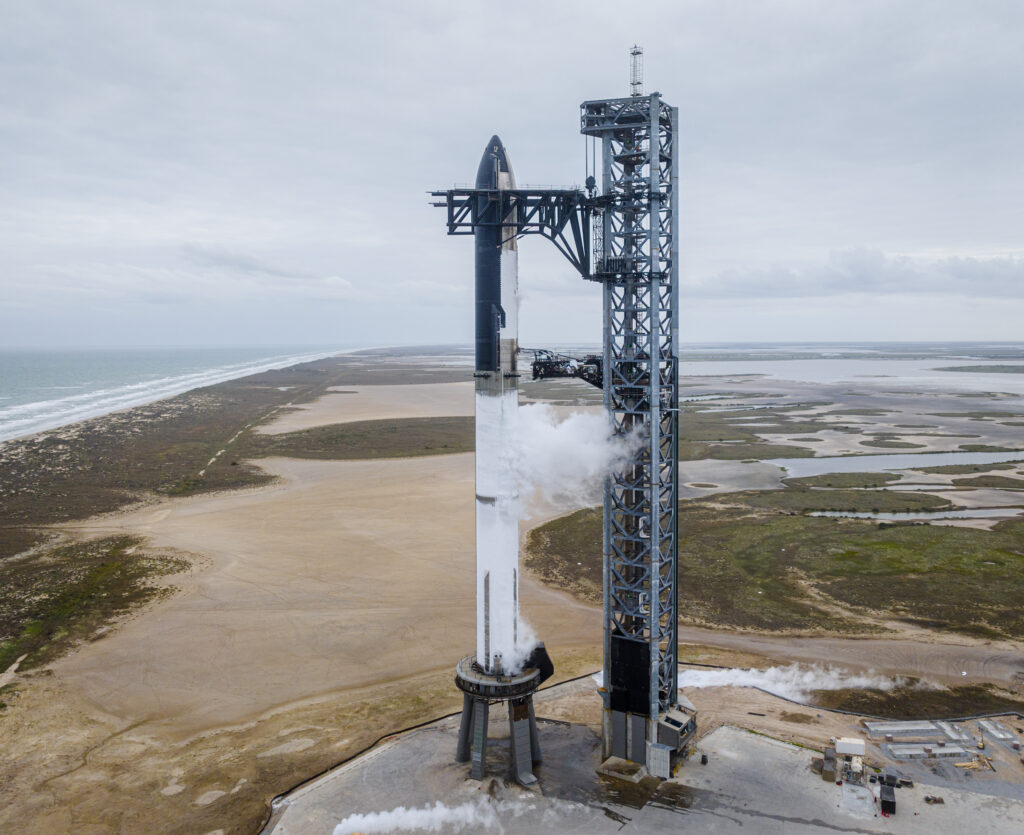
Prelims
I shared that for my 74th birthday in February, 2,335,132,800 seconds including 17 leap-days to be precise, Carol joined me at a COD presentation by astronomer, Joe DalSanto on the JWST. Joe’s presentations all always interesting and informative.
With the next US total solar eclipse less than a year away, April 8, 2024, I asked where people were planning to view it from. Keith and Dean will try Indianapolis, Beth and Chad Texas, and I am going to monitor the weather 3 days ahead of time to maximize chances for clear weather. Statistics say that the farther you go southwest in the 115 mile wide total eclipse path, the better your chances of clear skies. Click on this link to get more detailed information. This Sky & Telescope article is also very informative. There won’t be another total solar eclipse in the US until August of 2045, so don’t miss this one if you can. The 2018 eclipse that I watched down in Gallatin, TN was the most impactful observing event that I’ve ever witnessed.
On April 12, we celebrated Yuri’s Night commemorating the first manned space flight by Yuri Gagarin 62 years ago. Via a posted video, I saw Beth and Chad down at the Kennedy Space Center in Florida attending the event in their silver and gold outfits. Beth was wearing a red sash indicating that she was an official ambassador of the event. She brought the sash to our meeting and showed where an artifact from the early space program had been sewn into it. I’m proud that one of our members has such a national reach into the space community. She will also be one of the speakers at the upcoming Humans to Mars 2023 Summit in Washington DC on May 16-18. Go Beth!
I shared with the group this link to an astronomy textbook from Openstax that looks to be a very comprehensive and up-to-date resource. I plan to digest it fully and report back to the group about it.
Also coming up, is Astronomy Day at Harper College on April 29 at 5:00 to 9 PM. Dean will speak about the Artemis program and Kevin Cole, a Harper professor and astronomer, will report on the Mars rovers among many other topics and displays.
Next we watched a “Space Bites” episode from Fraser Cain. His weekly video on space and astronomy topics is my favorite resource for recent events. This episode from March 25 dealt with:
- The Japanese company, iSpace, sending the Hakuto-R lander to the moon on a Falcon 9 rocket. It carries 2 innovative small rovers. One is a 22 lb rover called Rashid built by the UAE and the other a baseball sized one from Japan. 7 other payloads are planned for deployment. The mission is only intended to last 10 days on the moon. The landing attempt is scheduled for April 25 in the Atlas crater on the edge of Mare Frigoris and hopefully, won’t spread tardigrades on the lunar surface like the Israeli mission, Beresheet, in April 2019. If successful it will be the first moon landing by a private company but many more missions are coming from NASA’s Commercial Lunar Payload Services (CLPS) program. An Apr 25 update: it looks like the Hakuto-R was not successful. That opens the door for the Nova-C Lander, from Intuitive Machines launching in June 2023 on a Falcon 9 rocket, to be the first private company to land on the moon.
- The Terran 1 rocket got to space but not into orbit because the second stage failed to ignite. This rocket is the first methane fueled US rocket and is 85% 3D printed. Beth shared that the rocket carried some of her “stories of space” as a payload. See “upcoming events in 2023” section for more details about “stories of space”.
- DART debris studied by earth based telescopes.
- Habitable planets around Alpha Centauri to be searched for by the Toliman cubesat launching in 2024.
- GAIA finds 1000+ more open star clusters in the Milky Way.
- NIAC awards have included studies to make bricks on the moon using human blood and potatoes.
- Moons around rogue planets could have life.
This last topic made me think about all the opportunities we have for life on moons within the solar system. There was a recent article about 12 more moons discovered around Jupiter. These moons are too small and not likely candidates for life but the current count for solar system moons is 224, Jupiter has 92, Saturn 83, Uranus 27, Neptune 14, Pluto 5, Mars 2 and Earth 1. Here is a picture showing the size of the larger moons compared to our Moon and the Earth. Note that a couple of the Galilean moons of Jupiter are as large as the planet Mercury.
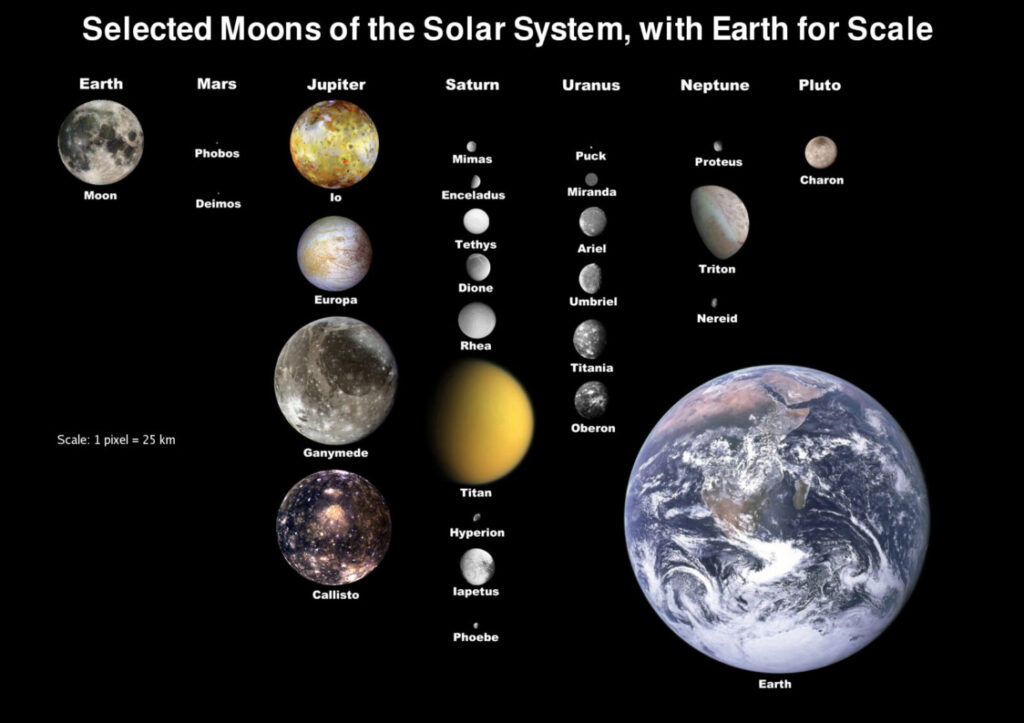
We didn’t have time but another video from Fraser Cain talked about why he is so obsessed with Venus. It talks about recent studies that show Venus has 85,000 volcanoes and 3 times the Earth’s land mass. There hasn’t been a US space probe to the planet in 30 years but activity is increasing. NASA plans 2 missions, Veritas (currently suffering a 3 year delay with a 2031 launch) and DaVinci+. Both are Discovery Class missions capped at $500 million each. They are not the Flagship type missions that cost over a billion dollars. Veritas’s delay is being blamed on budget limitations caused by the 2 year delay of the Psyche asteroid mission. Europe plans to send their Envision mission and a small rocket company, called RocketLab, is also is planning a probe.
Events That Occurred in 2022 Since Last Meeting
Artemis
Up to yesterday with the launch of Starship, the biggest event since our last meeting was the first launch of SLS/Orion with the Artemis 1 mission that circled the moon. The SLS launch occurred on Wednesday morning, Nov 16, 2022, at the wee hour of 12:47 AM Chicago time. Getting to the launch was not a straight line, you had to endure two scrubs and two hurricanes to get to the event. The 1st attempt was on Aug 29 but the countdown was stopped when an RS-25 engine indicated a pre-cooling fault (turned out to be a faulty sensor). The next attempt was on Sep 3, but it was halted due to a hydrogen leak at the quick-disconnect valve. A 3rd attempt was scheduled for later in September, but it was cancelled when hurricane Ian approached and the SLS was rolled back to VAB. After return to pad, hurricane Nicole caused cancellation of a Nov 12 launch date. On Nov 10, the rocket got a thorough drenching from the hurricane and survived 58 mph winds on the pad. Launch was rescheduled for Nov 16. The countdown, with its 2 hour window, went relatively smooth but there was a 43 minute hold to correct a hydrogen leak at a new spot (a replenishing valve) that problem was fixed by a “red” team who torqued down 2 bolts. A second problem with range safety was corrected by the Space Force replacing an Ethernet switch at a radar site. Keith and I were texting each other as we monitored the countdown. Finally, the rocket blasted off on a 25 day mission. The outbound trip to the moon took 5 days. After 15 days orbiting the moon, Orion and the Command Module blasted back to earth and Orion splashed down in the Pacific off San Diego. Here is NASA’s summary of the Artemis 1 mission.
There was a lot of drama with all the scrubs and launch delays of Artemis 1. The solid rockets on the side of the SLS had their expiration date extended multiple times and were set to expire again in December 2022. A second issue was the number of times the rocket was transported to and from the VAB and the launch pad. The SLS rocket had performed 5 rolls between the two locations. It is certified to only do 11, so 6 more transfers still remained. A final issue was that about 10 feet of caulk had come loose on the Orion capsule, raising concerns about its aerodynamic profile, but NASA did not consider it a problem.
Orion broke the record for the most distant crew-capable vehicle, eclipsing Apollo 13’s distance of 248,655 miles with 268,552 miles from Earth when it was in its Distant Retrograde Orbit. The upper stage of SLS launched about 10 cubesats on the way to the moon, but 6 of the 10 failed, possibly from drained batteries caused by the launch delays. On Nov 29, at distance of 40,000 miles from moon, Orion set the distance record of 268,552 miles from Earth.
Orion successfully splashed down in the Pacific off the coast of Baja California on Dec 11. Hopefully, Artemis, the new US return to the moon, will be different than Apollo. We have international partners, like the Europeans, who manufacture the command module that Orion is attached to and commercial partners like Spacex, who will get us down to the moon’s surface with a lunar version of their Starship. I wonder if the Dear Moon mission from SpaceX with the EveryDay Astronaut Tim Dodd and 8 other people will orbit around the moon like Apollo 8 before NASA can put 4 astronauts on the lunar orbiting Artemis 2 mission? Artemis 2 is scheduled for a Nov 2024 launch. NASA just announced the crew for Artemis 2 on April 3 with much fanfare. The crew of 4 consists of commander Reid Wiseman, pilot Victor Glover, mission specialist Chistina Koch and Canadian astronaut mission specialist Jeremy Hansen.
Regarding the Artemis 3 moon landing, I know Dean is very pessimistic about the Starship’s ability to land on the moon. With its enormous height, it seems very ungainly and presents a problem for astronauts to descend those last 164 ft to the surface. Also, the mass of Starship means that its landing engines will kick up a lot of moon dust. In Dec 2022, Bill Nelson, our NASA Administrator, said he thinks that SpaceX will do an uncrewed landing with Starship on the moon in 2023 and a crewed one in 2024. With the recent Starship launch, I think that timeline is too optimistic.
Post analysis considers the Artemis 1 mission a success but there are issues with the damage to the launch platform and amount of erosion on Orion’s heat shield. Return speed for Orion was 25,500 mph. It’s orbit got it to within 60 miles of the moon’s surface. This is the first time an initial launch of a new rocket has sent a payload to the moon. SLS thrust of 8.8 million pounds is 15% more than the Saturn 5’s 7.6 million and the 6.5 million of Space Shuttle. 75% of the SLS thrust comes from the solid boosters. Saturn 5 was taller at 363 ft compared to current SLS of 322 ft. Starship will be able to lift more than SLS with 100 mt versus 70 mt and with its 33 Raptor 2 engines, it will have 17 million pounds of thrust. Cost of the Artemis 1 launch was put at $4.1 billion. 4 of the previously reusable shuttle engines are now at the bottom of ocean. They will be discarded along with the rest of the SLS’s first stage on every launch. NASA has enough RS-25 engines for 3 more SLS flights. After that they will use newly manufactured ones intended for only one use.
Future missions in Artemis including Artemis 2 thru 4, were recently discussed by NASA. Artemis 3, the first manned lunar lander since Apollo 17 launched on Dec 7, 1972, is still listed as launching in 2025 but it will need the Starship to complete the landing and Artemis 4 is listed as 2027.
Falcon Heavy – SpaceX
After a 40 month hiatus, Falcon Heavy returned to flight on Nov 1, 2022 with a fog shrouded successful launch and a cool double landing back in Florida of the side boosters. The center core was expended at sea for performance reasons. So far, no center core from Falcon Heavy has been recovered. With the most recent launch of Falcon Heavy on Jan 15, 2023, the rocket has still never recovered the center core in all 5 of its missions. Open the “official video” text link in the above site to watch the launch, booster separation and landings with cheers from the SpaceX employees.
2022 was a successful year for SpaceX. The company tied a 42 year old Soviet record with 61 successful orbital launches in the year. SpaceX’s last launch in 2022 occurred on Dec 30. Over the years SpaceX has performed 193 successful Falcon 9 launches and 160 booster landings. 132 of the launches have reused a booster. Some boosters have been used up to 15 times. The launch record that they tied was from 1980, when the Soviet Union launched 64 R-7 rockets with 61 successes.
JWST early galaxies
What I most hope to see from JWST is the first stars and galaxies. There has been many announcements of early galaxies but sometimes the information seems a little premature because the results have not been confirmed. This first story contrasts the images of JWST to Hubble. The third image in the article does a blink comparison of the result from the two telescopes.
The next article talks about 2 galaxies, the farther one, GLASS-z12, is thought to be from 350 million years after the Big Bang. Astronomers up to this point are only looking at galaxies by their color at a few wavelengths and could be fooled by dust making them look redder and more distant than they really are. Full analysis with spectroscopy still needed to be done. The earlier red-shift of z=13 measurement has been refined down to 12.5. Brightness of the early galaxies is having astronomers rethink their assumptions about the earliest stars.
The furthest galaxy confirmed with spectroscopy is JADES-GS-z13-0. Its red-shift of z=13.2 gives it an age of 325 million years after the Big Bang. The previous record holder was GN-z11 (z=10.957) discovered by Hubble. That galaxy clocks in at 400 million years after Big Bang. There was a preliminary announcement of CEERS-93316 being only 235 million year after Big Bang and GLASS-z13 being only 300 million years after Big Bang but neither has been confirmed with the “gold standard” of spectroscopy. Good estimates can be obtained by using filters, this process is called photometry. But it uses just a few wavelength observations to see when the galaxies disappear. But those observations can be influenced by dust around the object. If you measure the distance to JADES-GS-z13-0 after the light has traveled for 15 billion years, it is now 33 billion light-years from Earth. The galaxy was originally discovered with JADES (JWST Advanced Deep Extragalactic Survey) as they searched in and around the Hubble Ultra Deep Field.
This presentation on 60 minutes might be the best in summing up the early JWST results.
There has been a lot of hype that JWST has broken the Big Bang theory. I think astronomers just have to reconfigure their assumptions on how galaxies got so big so fast. Some current theories suggest that the first stars, unfortunately called Population III by astronomers, were 100,000 times the mass of the Sun because they came from clouds of only hydrogen and helium without pollution from any heavier elements. Those stars because of their mass, lived fast and died young. It will be so cool if JWST could see these objects that might have formed only 200 million years after the Big Bang. I’d also like to find out how these first stars formed the first galaxies. Are globular clusters part of the story? It is like the old question “what came first, the chicken or the egg?”. In astronomical terms, the question is “what came first, the galaxy or the stars?”. Estimates are that JWST will be able to see back to 100 million years after the Big Bang, hopefully it will help unravel how the universe transformed from gas clouds to the beautiful structure we see today.
Events Coming in 2023
The first two items that are listed as “Events Coming in 2023” actually occurred before we met.
Starship launch
The elephant in the room was the Starship launch on Apr 20, 2023, one day before our meeting. Launch occurred relatively quickly after SpaceX received a launch license. One attempt on Apr 17 was scrubbed at T-6 minutes due to a frozen valve on the Super Heavy Booster. But that occurred after I watched the count-down for 2 hours, texting with Keith and Dean about progress and the likelihood of launch.
At first SpaceX announced a 2 day delay, but I knew Elon Musk wouldn’t miss his favorite date of 4/20, (April 4 is associated with the legalization of marijuana), by a day. So one more day was added. On Thursday, April 20, I woke up again at 2 AM, began watching the stream from NASASpaceFlight (NSF). I regret not switching over to SpaceX’s official stream because NSF coverage became spotty at the launch and they didn’t switch to SpaceX’s stream which had better camera coverage. There was a hold at 40 seconds which added to the tension, but in a couple of minutes the clock was counting down from T-30 seconds. The launch seemed to go well but the rocket didn’t seem to come off the launch pad completely vertical. Up to 5 engines were out at the beginning on the 33 engine first stage. I had heard that SpaceX was running them at only 90% power. Things looked bad at the +2 minute mark, with the rocket spiraling and stage separation not occurring. Eventually the rocket reached 39 km (24 miles) before the ground control commanded its destruction. Marcus House had a good video describing the launch.
My early opinion was that I considered the test a success as long as it didn’t destroy the launch pad and other infrastructure. Later, I really hoped they could have demonstrated Starship separate and ignition of its engines and controlled decent into the Pacific off Hawaii. But SpaceX has another 3-5 Starship/Super Heavy’s already manufactured, so the next test could come quickly. I didn’t realize how badly damaged the launch pad was even without an explosion. The crater below the pad and the pieces of concrete being hurled all around the vehicle might indicate a need for a flame trench and water suppression system which could delay things. Time will tell. Earlier Musk said he only thought there was a 50% chance of success. Ars Technica weighed in whether is was a success. I’ve heard that some of the people covering the launch have come down with a respiratory illness after breathing the brown dust that was blown a considerable distance. The FAA also has rescinded the launch license until SpaceX can address some of the launch issues. It might have been a better decision to wait for a water suppression system and maybe a flame trench needs to be installed.
The Super Heavy booster has 33 Raptor methane engines. Raptors are an amazingly powerful engine and can throttle down to 40% full thrust. At full thrust, it puts out 410,000 lb of force which is only a fourth of an F-1 engine (1.5 million lbf) on the Saturn 5. But remember the Saturn 5 had only 5 engines. Here is a picture contrasting the size of Saturn 5 – Starship/Super Heavy – Space Shuttle. Up to launch day, the record for the most powerful thrust rocket was the SLS at 8.8 million lbf. Saturn 5 had 7.6 million lbf but could actually get more mass into LEO than SLS. The Super Heavy is listed at 17 million lbf so it blows away the competition by a factor of almost 2. Its 33 engines reminds me of Russia’s N1 rocket with 30 engines and 10 million lbf. N1 was to be Russia’s manned moon rocket and could put 95 mt into LEO. N1 had 4 launch attempts in the 1960s. On attempt 1, it exploded at 12 km, attempt 2, it destroyed the launch pad. Fortunately, Russia had a second launch pad which it used for attempt 3 where the rocket only lasted 51 seconds and the 4th and last attempt, it reached 40 km which is the same height the Starship test reached. Russia abandoned the rocket after the 4 failed attempts. Here is some dramatic footage of the N1.
Lift to Low Earth Orbit (LEO) in metric tons (2200 lbs) for the various rockets are: Starship 150 mt; Saturn 5 140 mt; N1 95 mt; SLS Block 1 70 mt; SLS Block 2 130 mt; Falcon Heavy expendable 64 mt.
Here is a great animation that tried to anticipate the Starship Orbital Flight Test. The only thing that the animation had wrong is that SpaceX is not trying to catch the Super Heavy with the launch chop-sticks yet. They intended to put in down gently in the Gulf of Mexico. Starship also had no payload, so the Starlink satellite deployment is a future goal. I think SpaceX hoped Starship would get thru the atmosphere off Hawaii in one piece. They hoped to belly-flop it without any propulsion to slow it down. I think they didn’t expect it to remain intact after that several hundred mph splash into the ocean.
JUICE launch
The JUpiter ICy moons Explorer (JUICE) launched on April 14. It will take quite a convoluted route to Jupiter. It launched on the second to last Ariane 5 rocket. This has been a very successful rocket for Europe and among its 117 launches has been the JWST. The rocket is to be replaced by the Ariane 6 which has seen many delays and should first launch in the fourth quarter of 2023. JUICE’s 7.6 year trip includes 4 gravity assists; 1) Aug 2024 with the Earth-Moon system; 2) Aug 2025 with Venus; 3) Sept 2026 and 4) Jan 2029 with Earth. It arrives July 2031 and will first observe Ganymede, then Europa in July 2032, then Callisto in Aug 2032 to Aug 2033, and finally go into orbit around Ganymede for 9 months in Dec 2034. The probe will eventually crash into that moon in late 2035. It is the 10th space probe to explore Jupiter. The mission will spend 2.5 years orbiting Jupiter and Ganymede. The Europa Clipper mission from the US, launching on a Falcon Heavy in Oct 2024, should arrive first at Jupiter in Apr 2030, even though it will do gravity assists of Earth and Mars. It will be interesting with both probes orbiting Jupiter at the same time. Europa Clipper is also scheduled to crash into Ganymede early 2035 just before JUICE. Both probes have a ground penetrating radar to study the ice covered moons.
Stories of space
Beth shared that her “Stories of Space” project will be launching on a Falcon 9 rocket June 2023. She has been collecting stories and placing them on several varieties of SD cards. The memory cards will then be exposed to the harshness of space aboard the ISS and returned to Earth and evaluated as to how much radiation damage each type of card suffers.
Polaris Dawn Mission
Polaris Dawn mission has Jared Issacman again funding and piloting a Dragon capsule. It is targeted for the summer of 2023 for 5 day stand-alone mission. It will include the first spacewalk from a Dragon capsule. They are also researching whether they could boost the Hubble Telescope.
Starliner manned mission
Starliner was planned for April 2023 but has slipped to make way for the AX-2 mission launching on May 12 and the Vulcan rocket first launch which shares the same ULA launch pad with Starliner. It plans to be a 16 day stay by 2 astronauts on ISS with a launch no earlier than July 21, 2023. NASA also wants to do some more parachute tests on the Starliner capsule. If you don’t remember, Starliner is Boeing’s entry into the Commercial Crew competition. In 2014 SpaceX was awarded $2.6 billion and Boeing got $4.2 billion to develop their capsules. SpaceX flew their first manned flight in May 2020 and since have performed 6 production flights to the ISS. The NASA Inspector General has said the SpaceX Dragon seats cost $55 million each and the Boeing Starliner seats will cost $90 million each. Boeing appears to be over 3 years slower in development and twice as expensive to operate than SpaceX but I still think it is still a good move by NASA to have redundant capability. Especially with some of the strange behavior from the Russians. And their recent problems with coolant leaks on the Soyuz capsule.
Osiris-Rex sample return
The samples from the asteroid Bennu are to land in Utah on Sept 24, after a 7 year mission. The mission goal is to have at least 2.1 ounces of Bennu. This Week On NASA (TWON) episode deals with the CREW4 Dragon mission return from the ISS, the SLS crawler going to set a new record for the heaviest mobile platform and the Osiris-Rex probe’s return and the Dragonfly nuclear powered quad-copter that NASA will be sending to Saturn’s moon Titan. Fortunately, Titan has an atmosphere even more dense than Earth’s.
Vulcan rocket first launch
Vulcan is to be the replacement for the Atlas 5, which uses Russian manufactured engines. Since ULA is supposed to launch 60% of the US reconnaissance satellites, our military is much more comfortable with a US manufactured rocket. Blue Origin is providing the main engines, the methane burning BE-4 which has been much delayed. ULA was targeting a first launch on May 4, but an explosion with the Centaur upper stage on Mar 29 has put that date in jeopardy. The Peregrine Lunar Lander from Astrobotic is the intended payload for the first flight of Vulcan and the Dreamchaser space plane is the second launch payload. DreamChaser intends to be the third US cargo supply system to the ISS. The Perigrine Lander recently had its moon landing target changed to the Gruithusisen Domes on the western edge of Mare Imbrium from the original Lacus Mortis just north of the Mare Serenitatis. This Alpha Tech video deals with the Vulcan delays.
Psyche launch
NASA plans to launch the Psyche mission on Oct 10 on a Falcon Heavy rocket. The total mission cost, including Falcon Heavy launch is $985 million, of which $717 million have been spent as of June 2022. SpaceX launch cost is $117 million. The extra costs have resulting from the 2 year delay in launch, which now made NASA delay the Veritas Venus mission by 3 years. But at least we have two other Venus missions with DaVinci from NASA and ESA’s Envision. JPL is taking a hit for its hybrid work force during COVID for the reason that the Psyche software was late and unable to be tested before its 2021 launch date. The car sized spacecraft will visit the 226 km nickel and iron asteroid in August 2029. This link shows an artist’s rendering of what the asteroid, which is thought to be a piece of the core of a much larger body, looks like. This year’s launch window is Oct 5-25. Psyche will perform a flyby of Mars for a gravity assist to boost the probe into the asteroid belt between Mars and Jupiter. It will then perform a 26 month science study while in orbit around the asteroid. This maneuver is enabled by its electric propulsion thrusters.
First Two Lunar Landing CLPS Missions
The Nova-C Lander from Intuitive Machines should be the first Commercial Lunar Payload System(CLPS) mission to launch. It is headed to the crater rim of Malapert A near the south pole of the Moon. It will carry 5 NASA payloads and a commercial cargo. Launch is currently scheduled on a Falcon 9 rocket for June 2023.
The Peregrine Lander from Astrobotic is the second lunar landing mission in(CLPS). It is launching on the first flight of the new Vulcan rocket which has been delayed until the end of 2023. The lander has been retargeted to the Gruithusisen Domes not Lacus Mortis.
Both companies, Intuitive Machines and Astrobotic were part of the Lunar X Prize contest that wanted to incentivize private companies to land on the moon, travel a set distance and send a TV signal back of their accomplishment. None of the companies won the full Prize in the time allotted.
Record Stay on the ISS by Mark Rubio
Rubio will break the record for longest US stay in space, if he returns on Sept 27 on a Soyuz capsule. That date would give him 371 days in space breaking Mark Vande Hei’s record of 355 days (set Mar 2022 due to a Russian film crew using the Soyuz capsule) and Mark Kelly’s record of 340 days (set Mar 2016). Rubio’s record comes because the Russians had to send a replacement Soyuz because the original one sprung a leak in its coolant system, apparently from a micro-meteoroid strike. You can play a video of the Soyuz capsule leak in the above link. That capsule just returned to earth on March 28. It looks like the Russians made the right decision to bring the damaged capsule down without a crew because an unsubstantiated report listed the internal temperature as 50 degrees C (122 F) with an unknown humidity level. A replacement Soyuz has arrived on ISS on Feb 23 but Russia will wait until September to bring Rubio and 2 cosmonauts down. A supply Soyuz, called a Progress capsule, also suffered a coolant leak which seems unlikely to be another micro-meteor strike. More likely the leak is from a manufacturing defect. The world record stay in space is 437 days by Russian cosmonaut, Valeri Polyakov set in 1994-1995.
Miscellaneous
With Kid-Rock shooting up cases of beer with an automatic weapon because he disagrees with a person promoting his beer, it is nice to see a tongue-in-cheek humorous commercial from DM-2 Dragon mission and Space Shuttle pilot astronaut, Doug Hurley.
NASA
2024 Budget
The $27.2 billion for FY 2024 suggested by the Biden Administration is a 7.1% increase over last year’s NASA budget. But NASA’s budget pales compared to the $842 billion that the Department of Defense gets. The Space Force which is part of the DoD budget, even gets $30 billion which is $3 billion more than NASA. The Planetary Society’s, Casey Dreier, does a great job explaining the budget and breaks down the budget line by line. He welcomes the 7% increase which supports Artemis and Mars Sample Return (MSR) but questions the 3 year delay in the VERITAS mission , the first US Venus mission since the 1980s. The 3 year delay will raise costs and disrupt international partners in its goal to launch in 2029. MSR also is getting very expensive and complicated. It might turn into the new “project that ate the entire budget” like JWST was labeled in its later years. Also in jeopardy is the Uranus flagship mission that was recommended in the decadal survey. Early planning must be done to launch this mission in the next 5 years. Hopefully bipartisan support will occur in Congress and NASA will get its full proposed budget. Here are some more good diagrams of NASA’s budget and yearly plans. Russia only gives $3.1 billion for its space program.
Beth and Dean did a great podcast (episode #189 of Casual Space) talking about the NASA budget. My takeaway after listening was that Dean is optimistic that NASA will get its full funding because of concern about China competition. He was a little low in estimating the DoD budget at $480 billion. It is actually $842 billion for this coming year. The aeronautics section of NASA is budgeted for $996 million which includes an electric airplane and the needle sharp “low boom” X-59 plane that will fly around the US at 55,000 ft and mach 1.4 (mach 1 is 750 mph) testing what people think are acceptable sonic booms.
I used the Planetary Society website to encourage my Senators and Representative to: 1) support the NASA budget in full; 2) try to keep the Veritas mission funded and on schedule this year; and, 3) fully fund the NEO Surveyor spacecraft that will search for Earth threatening asteroids. The site automates the process of sending the emails based on your name and email and home addresses. I recommend it if your support the issues.
NASA Moon to Mars Strategy
Recently NASA released a 150 page document titled, “Moon to Mars Strategy“. There are also 6 white papers dealing with the Near Rectilinear Halo Orbit (NRHO) around the Moon, the Lunar Gateway, why we want to land at the moon’s south pole and other topics. I haven’t had time to digest the content yet but wanted to list it for your own perusal. In the overview of the presentation, I did like that NASA was listing sustainability, the use of Commercial & International partners and that science will be at the forefront as their goals.
SpaceX
Dear Moon Mission
I didn’t get a chance to ask the group whether they think the “Dear Moon” mission from SpaceX or Artemis 2 from NASA will fly a figure 8 around the Moon like the Apollo 8 mission in Dec 1968. The Artemis 2 crew of 4 has just been announced and the mission is scheduled for Nov 2024. The 9 people flying on the “Dear Moon” Starship were announced a while back and include Tim Dodd, the EveryDay Astronaut. With Starship destroying the launch pad down in Boca Chica a few days ago, I think the safe money is on NASA.
2023 YTD accomplishments
As of Apr 21, 2023, SpaceX for 2023 has had 24 successful Falcon 9 launches (with a total of over 4237 launched Starlink satellites since 2019), 1 Falcon Heavy launch and 1 launch of Super Heavy/Starship for a total of 25 orbital launches in 16 weeks.
Astronomy
Closest Black Hole
The newly discovered black hole is1600 light-years away and is 10 times the Sun’s mass. This is 3 times closer than the previous record holder. It was identified by observing the motion of its companion star, which orbits at a distance of 1 astronomical unit (AU). The Gaia spacecraft first identified it and the Gemini observatory in Hawaii confirmed it. It is located in the constellation Ophiuchus and named Gaia BH1. Sagittarius A*, the Milky Way’s super massive black hole is 26,000 light-years away. The first black hole discovered was Cygnus X-1 in 1964. It is 6200 light-years away and weighs in at 21 times the Sun’s mass.
Galactic Neutrinos
The first neutrinos from beyond the solar system were from the supernova of in the Large Magellanic Cloud 168,000 light-years away in 1987. That supernova was a type II caused by the collapse of a giant star. We saw the neutrinos hours before the visible light from the supernova because neutrinos are able to escape from the stellar explosion without collisions. Whereas the light takes a zigzag path and only escapes after a few hours. There were 25 neutrinos detected on Earth from the 1987 event. Now, with the Ice Cube experiment where you have a km of ice with detectors at the South Pole, astronomers have detected galactic neutrinos from M77, an active galactic nucleus 47 million light years away. The Nov 3 announcement said there were 70 neutrinos over background detected. Theory says the protons and other particles emitted from the accretion disk around the active black hole collide with matter creating the neutrinos. These M77 neutrinos are more energetic than the 1987 supernova ones.
Kilonova Rethink
The long gamma ray burst (GRB) (lasted nearly 2 minutes) stems from a neutron star merger, not the usual supernova explosion. Previously it was thought that neutron star mergers only created short GRBs (<2 seconds in duration). First GRBs were discovered in the 1960s by Vela satellites designed to detect nuclear explosions by the Russians. Short GRBs last less than 2 seconds. Long GRBs last a few minutes to several hours and thought to be from a massive stars going supernova. This GRB occurred last December in the constellation Bootes and is thought to be 1 billion light-years from earth. Most GRBs are 6 billion light-years away.
Closing
Well, that finishes all the topics that I had prepared for the meeting. Many of them we didn’t get to talk about. Here’s hoping that we won’t wait a half year to meet again. Our 12th anniversary is coming up in July, that seems like a good time to meet again. Ad Astra.
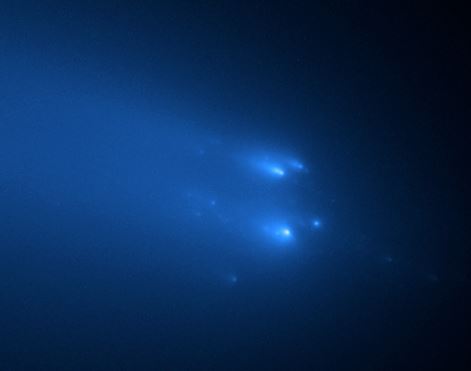
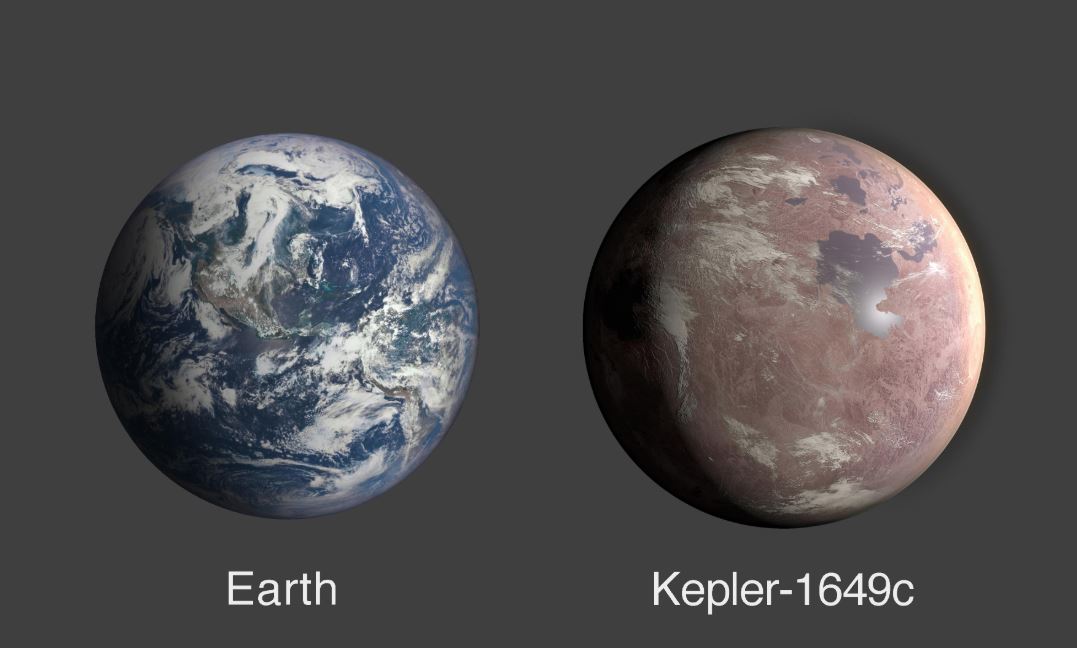
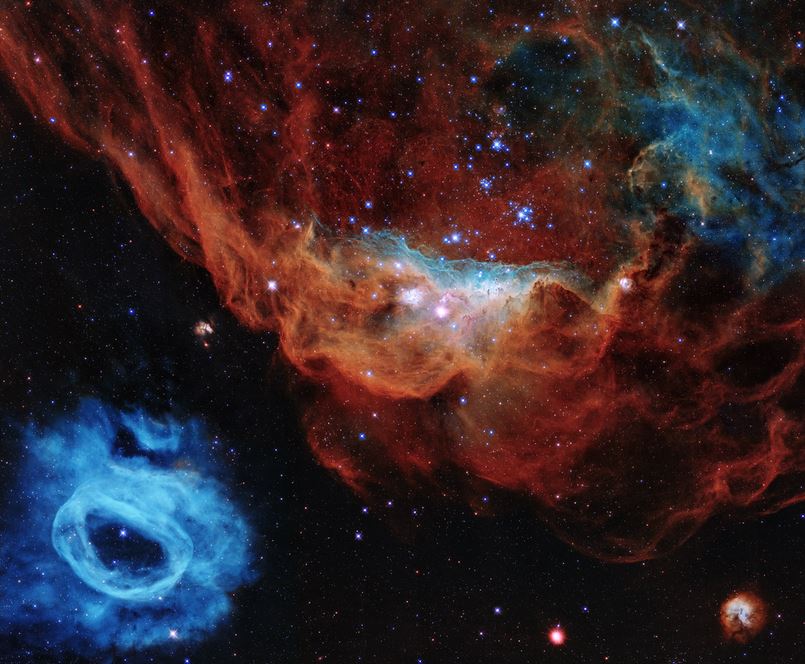
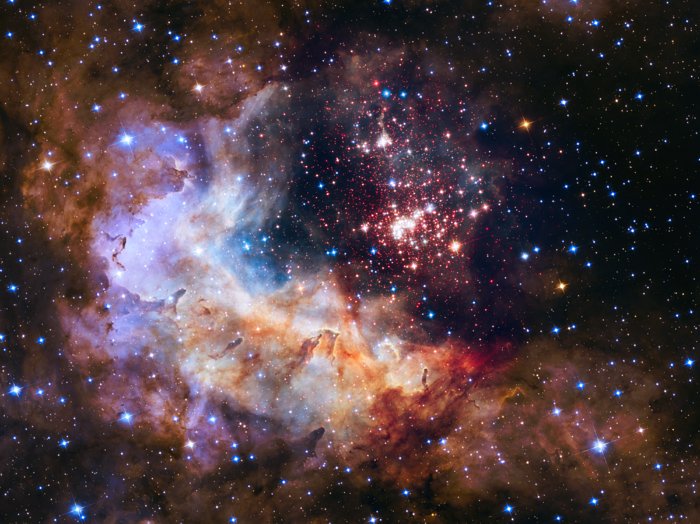
Recent Comments